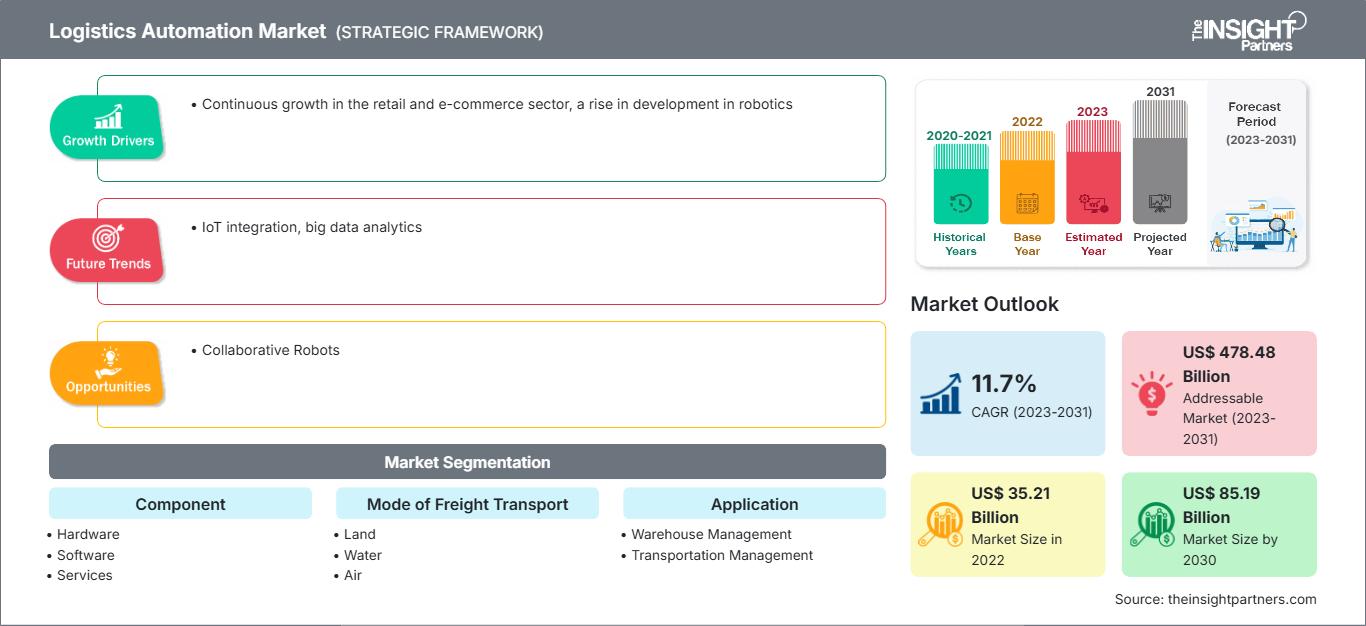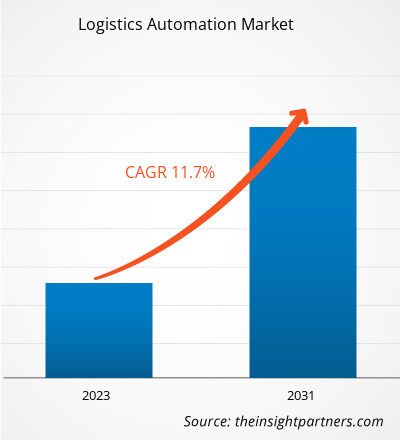물류 자동화 시장 규모는 2022년 352억 1천만 달러에서 2030년에는 851억 9천만 달러에 이를 것으로 예상됩니다. 2022년부터 2030년까지 연평균 성장률 11.7%를 기록할 것으로 예상됩니다. IoT 통합과 빅데이터 분석은 시장의 주요 트렌드로 남을 것으로 예상됩니다.
물류 자동화 시장 분석
소비자의 기대치가 높아짐에 따라 시장 참여자들은 창고의 IT 및 운영 기능에 대한 투자에 집중하고 있습니다. 기술 기업들이 분류부터 정리까지 모든 것을 자동화함에 따라 전 세계적으로 연결 기술이 빠르게 발전하고 있습니다. 이들은 최신 공급망 기술과 사물 인터넷(IoT)을 활용하고 있습니다. 스마트 창고는 공급망 프로세스의 효율성과 속도를 향상시키는 허브 역할을 합니다. 작업자의 웨어러블 기기부터 센서 및 스마트 장비에 이르기까지 인터넷 기반 기기와 기술은 물류 관리를 근본적으로 변화시킬 수 있습니다. 창고 및 운송 관리 분야에서는 공급망 전반의 상품 보관 및 이동을 자동화하는 물류 자동화 로봇을 적극적으로 도입하고 있습니다. 물류 자동화 로봇은 창고 및 보관 시설 전반에 통합되어 제품을 정리하고 운송합니다. 또한, 이러한 로봇은 수작업에 비해 향상된 가동 시간을 제공하여 업계의 생산성과 수익성 향상으로 이어집니다. 물류 로봇의 주요 활용 분야는 보관 시설 및 창고에 배치되어 상품을 운송하는 이동형 자동 가이드 차량(AGV)입니다. AGV는 창고 내 다양한 팔레트에 제품을 적재하고 보관하기 위해 미리 정의된 경로를 따라 작동합니다. AGV는 전체 물류 비용을 절감하고 공급망을 효율적으로 간소화하는 데 도움이 됩니다. 따라서 창고에서 로봇 활용이 증가함에 따라 향후 몇 년간 물류 자동화 시장 전망에 상당한 영향을 미칠 것으로 예상됩니다.
물류 자동화 시장 개요
물류 자동화 시장에서 자율주행차는 창고 및 야적장과 같이 정밀하게 제어되는 환경에 점점 더 많이 도입되면서 물류 사업에서 그 중요성이 최근 몇 년 동안 커졌습니다. 그러나 고속도로나 도심 도로와 같은 공유 및 공공 장소에 자율주행차를 배치하는 것은 물류 운영 최적화와 안전성 강화를 위한 업계의 다음 단계가 될 수 있습니다. AI 기술 발전의 확대와 센서 및 시각 기술 개발에 대한 막대한 투자 증가는 자율주행차 개발에 도움이 될 수 있습니다. 자율주행차와 드론은 자동화된 물류 시스템의 중요한 구성 요소입니다. 예를 들어 구글과 테슬라는 무인차 기술 분야에서 상당한 발전을 이루었습니다. 자율주행은 지난 20년 동안 레이더 기술과 컴퓨터 성능의 비약적인 발전 덕분에 공상과학 소설에서 실현 가능한 현실로 발전했습니다. 휴대용 기술이 발전하여 초경량 하드웨어가 자체 개선 알고리즘을 기반으로 의사 결정을 내릴 수 있게 되면서, 엔지니어들은 자율주행차에서 인간의 의사 결정을 모방할 가능성이 더 높아졌습니다.
이 보고서의 일부, 국가 수준 분석, Excel 데이터 팩을 포함하여 모든 보고서에 대한 사용자 정의를 무료로 받을 수 있을 뿐만 아니라 스타트업 및 대학을 위한 훌륭한 제안 및 할인을 이용할 수 있습니다
물류 자동화 시장: 전략적 통찰력

-
이 보고서의 주요 주요 시장 동향을 확인하세요.이 무료 샘플에는 시장 동향부터 추정 및 예측에 이르기까지 데이터 분석이 포함됩니다.
물류 자동화 시장 성장 동력 및 기회
소매 및 전자상거래 부문의 지속적인 성장으로 시장 호조세 기대
물류 자동화는 재고, 추적, 포장, 창고 및 배송 문제를 관리하는 전자상거래의 핵심 요소 중 하나입니다. 소매 및 전자상거래에서 기업은 적시 배송 및 반품 정책을 준수해야 할 책임이 있습니다. 상품 교체가 필요한 경우, 기업은 역물류의 모든 작업을 처리해야 합니다. 소매 및 전자상거래 사업에서 물류 자동화 공급업체는 향상된 기술, 확장성, 유연성 및 효율성을 제공합니다. 또한, 전자상거래 부문은 성장하고 있습니다. 예를 들어, 인도는 2020년 이후 1억 2,500만 명의 온라인 쇼핑객을 확보했으며, 2025년까지 8,000만 명이 추가로 증가할 것으로 예상됩니다.
물류 자동화 소프트웨어 회사가 소매 및 전자상거래 기업에 제공하는 물류 요구 사항 및 서비스에는 창고 관리, 공급망 관리, 통합 서비스 및 주문 처리가 포함됩니다. 기업이 물류 자동화 서비스 제공업체를 통해 물류 업무를 아웃소싱하면 전자상거래와 관련된 여러 이점을 누릴 수 있습니다. 이를 통해 소매 및 전자상거래 참여자는 각자의 역할을 수행할 수 있습니다. 물류 자동화 회사는 공급망 관리를 전문으로 하며, 이를 통해 온라인 매장은 마케팅 및 기타 비즈니스 운영을 강화할 수 있습니다. 물류 자동화 소프트웨어를 통해 창고 관리자는 다중 품목 분류, 분할 케이스 피킹, 팔레타이징과 같은 다양한 프로세스를 효율적으로 처리할 수 있습니다. 따라서 물류 자동화 소프트웨어는 전 세계 소매 및 전자상거래 부문에서 엄청난 기회를 가지고 있으며, 이는 물류 자동화 시장 성장을 촉진할 수 있습니다.
협동 로봇
다양한 비즈니스 분야와 산업 프로세스에 협동 로봇이 도입된 이후, 물류 및 창고 산업은 생산성과 효율성이 향상되어 다양한 서비스 제공업체가 증가하는 수요를 충족할 수 있게 되었습니다. 협동 로봇 기술은 끊임없이 발전하고 있으며, 4차 산업혁명의 도래에 따라 공급망 효율성과 창고 산업은 앞으로도 계속해서 이점을 누릴 것입니다. 코봇은 창고나 물류 센터와 같은 특정 작업 공간에서 사람과 협업하도록 설계 및 제작되었기 때문에 인명 부상 위험을 줄이는 데 도움이 되는 다양한 기능을 수행합니다. 코봇은 인공지능(AI)과 머신러닝 기술을 사용하여 적절하고 효율적으로 작동하도록 설계되었습니다.
물류 자동화 시장 보고서 세분화 분석
물류 자동화 시장 분석 도출에 기여한 주요 분야는 구성 요소, 화물 운송 방식, 애플리케이션, 그리고 최종 사용자 산업입니다.
- 구성 요소를 기준으로 물류 자동화 시장은 하드웨어, 소프트웨어, 서비스로 구분됩니다. 하드웨어 부문은 2022년에 가장 큰 점유율을 기록했습니다.
- 화물 운송 모드별로 시장은 육로, 해상, 항공으로 세분화됩니다.
- 응용 프로그램별로 시장은 창고 관리 및 운송 관리로 세분화됩니다.
- 최종 사용자 산업별로 시장은 제조, 소매 및 전자 상거래, 석유 및 가스, 식음료, 자동차, 의료 및 제약, 기타로 세분화됩니다.
지역별 물류 자동화 시장 점유율 분석
물류 자동화 시장 보고서의 지리적 범위는 주로 북미, 아시아 태평양, 유럽, 중동 및 아프리카, 남미 및 중미의 5개 지역으로 나뉩니다.
아시아 태평양은 2022년 물류 자동화 시장에서 가장 빠르게 성장하는 지역입니다. 아시아 태평양은 경제가 성장하고 있으며, 이는 소매 및 전자 상거래, 제조, 석유 및 가스, 식음료, 자동차, 의료를 포함한 다양한 부문의 성장으로 이어지고 있습니다. 이 지역 전역에서 첨단 혁신 기술 도입률이 높습니다. 소매 및 전자상거래 산업 발전을 위한 정부의 투자와 다양한 정책 덕분에 아시아 국가에서 물류 자동화 솔루션 도입이 꾸준히 증가하고 있습니다.
이 지역은 강력한 전자상거래 산업을 보유하고 있으며, 이 지역의 창고에는 최첨단 기술이 도입되어 있습니다. 또한 공급업체의 제품 수가 증가함에 따라 창고 관리 부서는 체계적이고 실행 가능한 운영을 위해 로봇 공학 및 물류 자동화 소프트웨어를 도입하고 있습니다. 아시아 신흥 시장은 시장 경쟁력 강화, 비용 압박, 인플레이션 유발 요인, 시장 변동성 등의 어려움에 직면해 있습니다. 따라서 공급망 계획 및 실행이 복잡해지고 있습니다. 이러한 문제를 해결하기 위해 제조업체와 공급업체는 가시성을 개선하고 재고 관리 프로세스를 개선하여 아웃바운드 및 인바운드 공급망 관리를 극대화할 수 있는 물류 자동화 서비스를 적극적으로 도입하고 있습니다.
물류 자동화
물류 자동화 시장 지역별 통찰력
The Insight Partners의 분석가들은 예측 기간 동안 물류 자동화 시장에 영향을 미치는 지역별 동향과 요인을 면밀히 분석했습니다. 이 섹션에서는 북미, 유럽, 아시아 태평양, 중동 및 아프리카, 그리고 중남미 지역의 물류 자동화 시장 부문 및 지역별 현황도 다룹니다.
물류 자동화 시장 보고서 범위
| 보고서 속성 | 세부 |
|---|---|
| 시장 규모 2022 | US$ 35.21 Billion |
| 시장규모별 2030 | US$ 85.19 Billion |
| 글로벌 CAGR (2023 - 2031) | 11.7% |
| 이전 데이터 | 2020-2021 |
| 예측 기간 | 2023-2031 |
| 다루는 세그먼트 |
By 구성 요소
|
| 포함된 지역 및 국가 |
북미
|
| 시장 선도 기업 및 주요 회사 프로필 |
|
물류 자동화 시장 참여자 밀도: 비즈니스 역학에 미치는 영향 이해
물류 자동화 시장은 소비자 선호도 변화, 기술 발전, 그리고 제품 이점에 대한 인식 제고 등의 요인으로 인한 최종 사용자 수요 증가에 힘입어 빠르게 성장하고 있습니다. 수요가 증가함에 따라 기업들은 제품 및 서비스를 확장하고, 소비자 니즈를 충족하기 위한 혁신을 추진하며, 새로운 트렌드를 적극 활용하고 있으며, 이는 시장 성장을 더욱 가속화하고 있습니다.

- 을 얻으세요 물류 자동화 시장 주요 주요 플레이어 개요
물류 자동화 시장 뉴스 및 최근 동향
물류 자동화 시장은 1차 및 2차 조사 이후 주요 기업 간행물, 협회 데이터, 데이터베이스 등 정성적, 정량적 데이터를 수집하여 평가합니다. 물류 자동화 시장의 몇 가지 동향은 다음과 같습니다.
- OMRON은 싱가포르, 동남아시아, 오세아니아 고객층을 대상으로 싱가포르에 첫 번째 물류 자동화 센터를 개소한다고 발표했습니다. (출처: OMRON, 보도자료, 2022년 12월)
- FM Logistic은 인도에 다섯 번째 다중 고객 시설(최초 자체 소유 시설)을 개소했습니다. (출처: FM Logistic, 보도자료, 2022년 5월)
물류 자동화 시장 보고서 범위 및 결과
“물류 자동화 시장 규모 및 예측(2020~2030년)” 보고서는 다음 영역을 포괄하는 시장에 대한 자세한 분석을 제공합니다.
- 범위에 포함된 모든 주요 시장 부문에 대한 글로벌, 지역 및 국가 수준의 물류 자동화 시장 규모 및 예측
- 물류 자동화 시장 동향 및 동인, 제약 및 주요 기회와 같은 시장 역학
- 자세한 PEST/포터의 5가지 힘 및 SWOT 분석
- 주요 시장 동향, 글로벌 및 지역 프레임워크, 주요 업체, 규정 및 최근 시장 개발을 포괄하는 물류 자동화 시장 분석
- 시장 집중도, 히트맵 분석, 주요 업체 및 물류 자동화 시장의 최근 개발을 포괄하는 산업 환경 및 경쟁 분석
- 자세한 회사 프로필
- 과거 분석(2년), 기준 연도, CAGR을 포함한 예측(7년)
- PEST 및 SWOT 분석
- 시장 규모 가치/거래량 - 글로벌, 지역, 국가
- 산업 및 경쟁 환경
- Excel 데이터세트
최근 보고서
관련 보고서
사용 후기
구매 이유
- 정보에 기반한 의사 결정
- 시장 역학 이해
- 경쟁 분석
- 고객 인사이트
- 시장 예측
- 위험 완화
- 전략 기획
- 투자 타당성 분석
- 신흥 시장 파악
- 마케팅 전략 강화
- 운영 효율성 향상
- 규제 동향에 발맞춰 대응






















 무료 샘플 받기 - 물류 자동화 시장
무료 샘플 받기 - 물류 자동화 시장